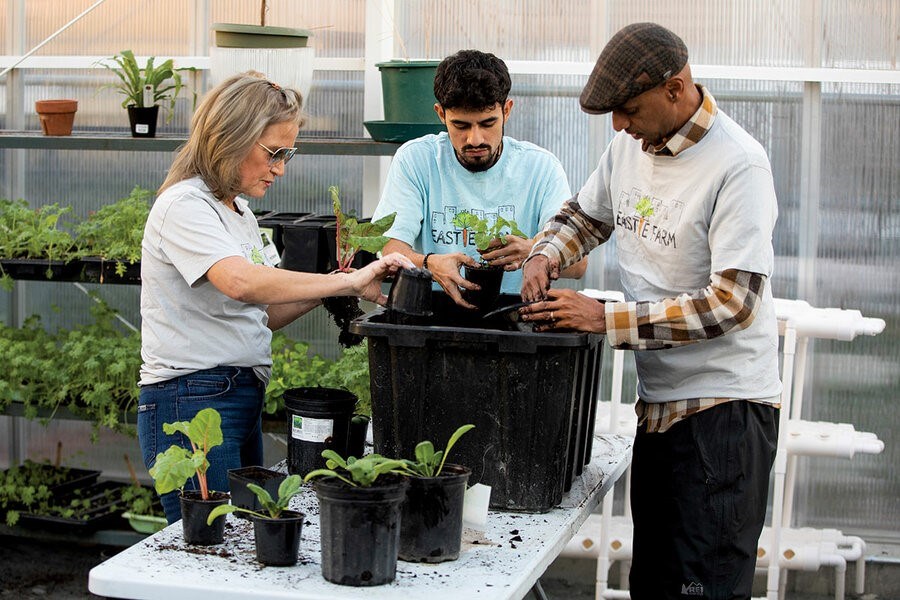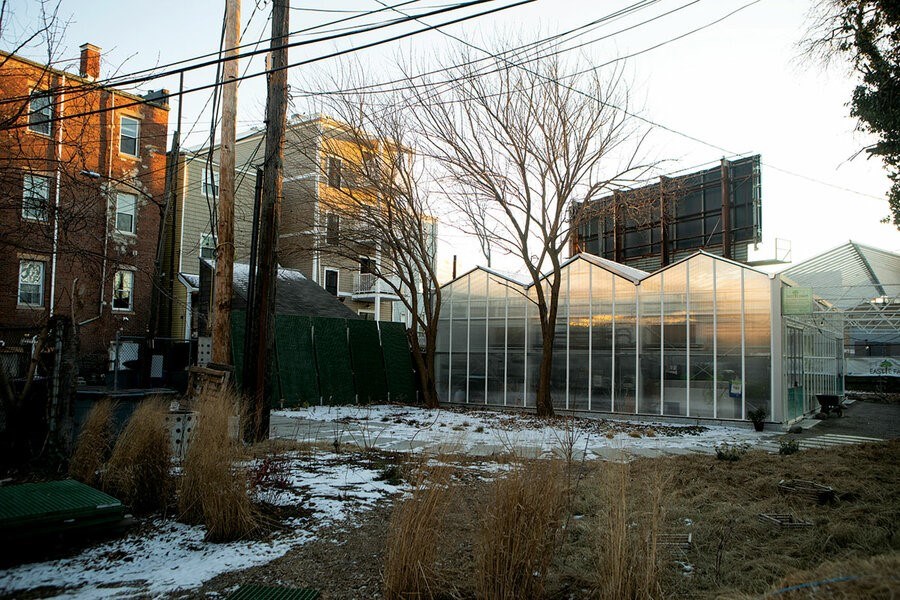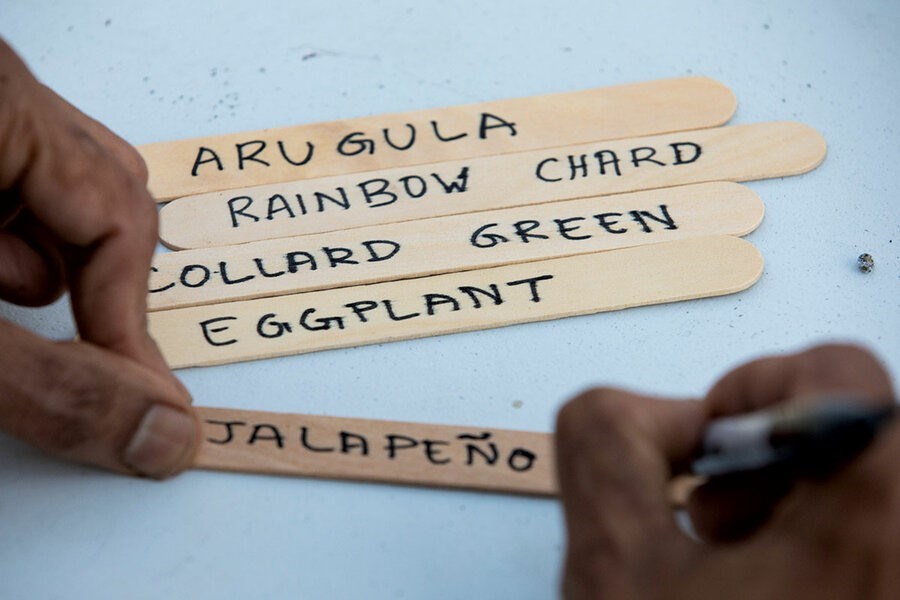REPRINTED WITH PERMISSION FROM THE CHRISTIAN SCIENCE MONITOR
 Heather O'Brien (from left), Sebastian Tabares, and Kannan Thiruvengadam repot young plants at Eastie Farm's greenhouse. Melanie Stetson Freeman/Staff
Heather O'Brien (from left), Sebastian Tabares, and Kannan Thiruvengadam repot young plants at Eastie Farm's greenhouse. Melanie Stetson Freeman/Staff
February 23, 2023
Tucked near a highway underpass, a greenhouse glows faintly in the cold night. Inside, volunteers stand in the warmth, crowded around two pizzas topped with homegrown basil. Rows of potted greens, herbs, peppers, eggplants, and even strawberries line shelves along the walls.
The greenhouse is a new project of Eastie Farm, a nonprofit educational urban farm founded in 2016 and housed in East Boston. Focused on feasible climate action, the nonprofit – and its new greenhouse – provides the surrounding community with greater control over its food supply. The building runs on geothermal energy and is the first of its kind in New England. As a model of what 21st-century development could look like, the greenhouse represents a practical application of geothermal, an often inaccessible technology.
“Everything that we do, we try to make sure that it has a relevance here and now, and it serves the purpose for the people who are living here today,” says Kannan Thiruvengadam, the director of Eastie Farm. “This technology is already possible. You don’t have to wait for tomorrow or the day after.”
The geothermal greenhouse operates as a heat exchange. Below the frost line, Earth’s temperature stays at a steady 50 to 60 degrees Fahrenheit year round. A fluid composed of water and antifreeze is pumped up from the ground, runs through a compressor, passes over a warm coil, and finally blows into the greenhouse as warm air. The fluid then heads back underground, forming a closed loop system.
 Melanie Stetson Freeman/StaffEastie Farm’s geothermal greenhouse is warmed in the winter and cooled in the summer by heat exchange, using pipes that circulate a fluid underground. Crops will be grown during all seasons for the East Boston community.
Melanie Stetson Freeman/StaffEastie Farm’s geothermal greenhouse is warmed in the winter and cooled in the summer by heat exchange, using pipes that circulate a fluid underground. Crops will be grown during all seasons for the East Boston community.
Warmth in the winter
By drawing the temperature below the frost line up and into the greenhouse, the system warms in the winter and cools in the summer. Add in some warmth from sunshine, and winter temps in the greenhouse can be as high as 70 degrees.
Inspiration for the greenhouse sparked during one of Eastie Farm’s nature classes taught to local students: Kids wanted an opportunity to get outside and farm in the colder months. “They even asked, ‘Come on, there must be something we can grow in the wintertime,’” Mr. Thiruvengadam remembers. “I said, ‘Grow ice!’”
There was no one to guide Eastie Farm through the project – because it hadn’t been done before. Greenhouses are typically powered by propane and aren’t all that green, despite their name. They leak warm air in the winter and are often abandoned or used as storage in the hot summer months.
Funding entities and contractors alike were unsure how to help. Information was crowdsourced. On Oct. 13 – at 9:37 in the morning – the greenhouse began to fill with warm air, without any help from fossil fuels.
Greenhouse manager Will Hardesty-Dyck aims to use the 1,500-square-foot enclosure to grow year-round, for about 2,000 pounds of produce yearly.
Inside the greenhouse, string lights crisscross the ceiling underneath an insulation layer that is pulled tight to trap the daylight’s long-gone heat inside the building. The smell of soil fills the space with the feeling of spring.
 Melanie Stetson Freeman/StaffStaff members, including greenhouse manager Will Hardesty-Dyck (right), work to set up the geothermal greenhouse at Eastie Farm.
Melanie Stetson Freeman/StaffStaff members, including greenhouse manager Will Hardesty-Dyck (right), work to set up the geothermal greenhouse at Eastie Farm.
“I just really love growing plants,” Mr. Hardesty-Dyck says. “That makes me tick – and then being able to do that in this sort of organization where we’re really engaging with people and addressing needs.”
The neighborhood Eastie Farm serves is as unique as its greenhouse. East Boston is a community that suffers a disproportionate burden of climate hazards. The peninsula is home to Boston Logan International Airport, houses stores of petroleum-derived products, and is at risk of climate-related flooding. It also experiences a high level of food insecurity.
Mr. Hardesty-Dyck is already fielding requests to house budding saplings as well as to cultivate culturally relevant foods that may not be available – at least not fresh – at supermarkets. South and Central American community members have asked for tropical and subtropical fruits, such as mamoncillo. There have also been requests for herbs such as cilantro and mint, a common ingredient in Moroccan tea.
Communal purpose
Eastie Farm aims to ensure that there is no stigma for immigrant and other community members in accessing good food – an effort rooted in the idea that economic insecurity is at the heart of food insecurity. By partnering with local farms that share their values, Eastie Farm provides a community-supported agriculture (CSA) program with three levels: paid, subsidized, and free.
 Melanie Stetson Freeman/StaffKannan Thiruvengadam, director of Eastie Farm, writes plant names on sticks.
Melanie Stetson Freeman/StaffKannan Thiruvengadam, director of Eastie Farm, writes plant names on sticks.
“The reality is that we don’t have a lot of access to fresh fruits and vegetables. So the farm really is a great way to expose yourself to a variety that you don’t easily get in the stores that we have,” says Bessie King, a CSA subscriber and East Boston resident.
Eastie Farm challenges the conventional definition of an urban farm.
“Urban farms have more to harvest from their proximity to a lot of consumers and from their connections with rural farms than just by maximizing what [they grow] in every square inch,” Mr. Thiruvengadam says.
Shani Fletcher, director of GrowBoston, Boston’s Office of Urban Agriculture, agrees. “Eastie Farm is a great example of innovative urban agriculture,” she says. “I think we need to try everything we can ... to both make our city climate-resilient and to mitigate climate change.”
One of the pillars of the nonprofit is education. Students can learn about the greenhouse effect and its meaning for the planet while standing in a greenhouse and experiencing it hands-on. The farm also manages four school gardens, which give students “ownership or buy-in to the school community,” says Sam Pichette, a fifth grade teacher at Bradley Elementary whose students have participated in nature classes here. “It helped to strengthen ties between the students and to the community they live in.”
Eastie Farm gives residents agency in a community that faces overdevelopment and gentrification, says Ms. King. “A place like Eastie Farm is a beacon of hope because it’s run by community members; it’s run by volunteers; it’s run by fellow farms that are all local.”
At the end of the night, everyone lines up to take home small bags of assorted greens. “Party favors!” says a smiling volunteer in a bright pink coat. It is the beginning of many expected greenhouse crops.
Related stories
Page created on 2/27/2023 8:22:10 PM
Last edited 2/27/2023 8:33:30 PM
